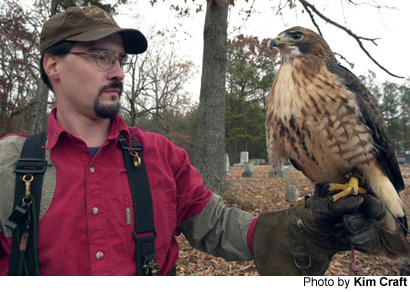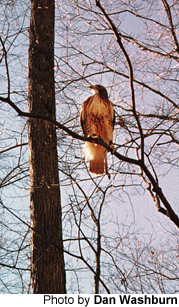
January 30, 2001 — It was just a squirrel. That’s what I keep trying to tell myself.
But when that rodent ran toward me, it stirred something. My heart quickened. My palms became sweaty.
It was just a squirrel, I know. And I realize the hawk was to do all the hunting, that I was just there to watch.
But for a split second, our eyes met — and I felt as though I was part of the battle.
The frenzy that flowed from my lips was foolish. Believe me, I’ve listened to it over and over. I tape record these little adventures, you know.
“There he is. He’s right here! I think … he’s on top of it! They’re both on the ground! Right here! Coming at me! Coming at me! Right here, Spud! Over there! Over there! Over there!”
Spud is a red-tailed hawk — he doesn’t speak English.
The squirrel darted off. Its furry tail disappeared deep within the forest.
Spud remained nearby, however.
He breathed heavily through his open beak. Some squirrels get away.
He bled slightly from the back of his foot. Some squirrels bite back.
“There you go,” States Wing, Spud’s trainer, said as he fed the bird a small slice of fresh venison. Spud earned it.
This pause was preceded by a deathly dance that skipped from tree to tree before it tumbled to the ground. It was hide and seek at Mother Nature’s house, and States and I had front-row seats.
Hawking, often referred to as falconry, is an ancient pastime that can be traced back to the 8th century B.C. It is the sport of employing a trained bird of prey in the hunting of wild game.
“I don’t consider it hunting,” said States, 35, a Gainesville native who now lives in Suwanee. “I consider it more observing. Because the bird is doing all the work.”
Not that a falconer doesn’t put in his share of time and effort. In fact, the sport is a year-round endeavor with strict rules and regulations. Unlike shotguns and bows, birds can’t be stowed and forgotten during the offseason. And a series of rigorous tests, followed by a period of apprenticeship, is required before the hunter even gets started.
Thus, falconers are few, but they are a decidedly dedicated lot.
The birds are trapped and trained, conditioned to associate food with the falconer. So for three years now, States has played the role of surrogate father for Spud, teaching the hawk “better hunting skills that a parent would teach him.”
But don’t be fooled. These hawks and falcons are still wild.
Four years ago, after six weeks of diligent training, States took his first bird out for its initial hunt. He let the hawk loose and it flew away, never to be seen again.
Spud, by the way, wears a radio transmitter around his leg.
He also wears a string of bells, which proved to be very helpful during our hawking trips on two very different afternoons — the first, cold and rainy, in mid-December; the second, sunny and clear, last week — in separate tracts of trees near Cumming.
 Untethered in the woods, Spud can disappear without moving. It’s God’s camouflage, I suppose. When he moves, you hear the bells first. Then you see Spud emerge from the backdrop and grandly glide through the air.
Untethered in the woods, Spud can disappear without moving. It’s God’s camouflage, I suppose. When he moves, you hear the bells first. Then you see Spud emerge from the backdrop and grandly glide through the air.
He finds a high perch and watches the forest like, well, like a hawk. He scans for movement — for food.
To a hawk, a full belly is life’s ultimate goal.
Meanwhile, States roams among the fallen leaves, making noise, knocking trees, pulling vines — anything that might roust a rodent.
Normally, this is the job of the hunting dog. But sadly, States’ German wirehaired pointer was killed by car late last year. And a good hunting dog is not easily replaced.
We moved through the woods, and Spud would eventually follow. We could tell by the jingle of bells.
Once a squirrel appeared, however — either to hawk or human — everything stopped, and the game began.
“Ho, ho, ho, ho, ho!” States would yell. “Get him Spud! Get him!”
Once the players are positioned, both in the same tree, nature takes over. Well, almost. Sometimes States helps nature along with his trusty slingshot. He shoots marble after marble (he buys them in lots of 4,000) in the vicinity of the squirrel, which must feel as though it’s having the worst day of its life.
These treetop tussles can be time consuming, hawk and squirrel never wanting to give the other a tactical advantage. They are methodical in their movements, until one of the parties decides to make its move. Then the action is fast and furious — and rather fan friendly, all except for the sore neck.
Take one of our chases last week, for example. Spud swooped down on a squirrel nest, giant talons first, and sent its occupant scurrying down the side of the tree.
Like before, excitement got the better of me: “Coming down! Coming down on the ground right here!” I yelled. “He’s running across the field!”
And, without thinking, I sprinted after it. There I was, chasing a squirrel. “Ho, ho, ho, ho, Spud!” I called.
But the squirrel was gone. And States was laughing at me.
Most squirrels are alive because they know how to stay that way. They can hop from tree to tree with ease, and apparently no fall is high enough to hurt them. They can escape into cover with cunning.
“They’re little magicians,” States said with a smile. And on this day, they successfully made themselves disappear. But not so back in December, when Spud spiraled a squirrel to the top of a pine tree and pounced on it.
The cries told us that he had it. Now all we needed was for Spud to come down.
“The problem is, as high as he caught it and as windy as it is,” States said, “he might bring it down in DeKalb County.”
Well, not exactly. Spud eventually carried his catch to another treetop. And then, after some coaxing, he came down … along a creek bed some 300 yards into the woods. We chased and eventually found him on the ground, still trying to put the finishing touches on the squirrel in his grasp.
It seems squirrels are as tough to kill as they are to catch.
States helped things along with a few snips of his scissors. And then Spud finally had the feast he had worked so hard for.
It wasn’t pretty. But it was nature.
